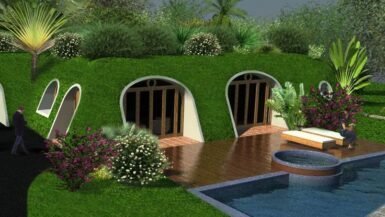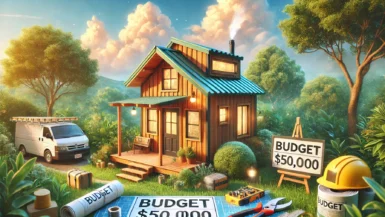In an era where environmental consciousness and sustainability have become paramount, the concept of tiny homes has emerged as a popular and innovative solution. The following article, “The Role of Tiny Homes in Reducing Carbon Footprints,” delves into the intricacies of this housing trend, focusing on its potential to minimize our ecological impact. As we explore the benefits of downsized living spaces, we will examine the design principles, efficient use of resources, and lifestyle changes associated with tiny homes. With a keen emphasis on their role in mitigating climate change, this article offers a comprehensive understanding of how adopting the tiny home movement can contribute to a more sustainable future for our planet.
Energy-efficient design features of sustainable tiny homes
The architectural and design elements of sustainable tiny homes play a crucial role in reducing their carbon footprint. By incorporating energy-efficient features into their structures, these dwellings can minimize their environmental impact and lower energy consumption. In this section, we will explore various design aspects of sustainable tiny homes, focusing on their ability to promote energy efficiency and environmentally-friendly living.
Maximizing natural light
One of the key design principles in sustainable tiny homes is utilizing natural light to its full potential. Large windows, skylights, and strategically placed openings allow for ample daylight to enter the living space, reducing the need for artificial lighting. This not only saves energy but also creates a well-lit, warm, and inviting atmosphere.
Insulation and thermal performance
Proper insulation is essential for maintaining a comfortable indoor temperature and reducing energy consumption in any home, regardless of size. Sustainable tiny homes often use high-quality insulation materials, such as sheep’s wool, recycled denim, or rigid foam, to minimize heat loss in the winter and keep the interior cool in the summer. Additionally, double-glazed windows and tight building envelopes prevent drafts and further enhance thermal performance.
Energy-efficient appliances and fixtures
Another aspect of sustainable tiny home design is the incorporation of energy-efficient appliances and fixtures. This includes items such as LED lighting, Energy Star-rated appliances, and low-flow water fixtures. By opting for these energy-saving alternatives, tiny home dwellers can significantly reduce their overall energy consumption and associated carbon emissions.
Smart home technology
Incorporating smart home technology into sustainable tiny homes can further enhance energy efficiency. With features such as programmable thermostats, energy monitoring systems, and smart lighting controls, tiny home residents can manage their energy usage more effectively and make informed decisions to minimize their environmental impact.
Passive solar design
Passive solar design principles can be integrated into tiny home construction to harness the sun’s energy for heating and cooling purposes. This may involve orienting the home to maximize southern exposure, using thermal mass materials to store heat, and installing shading devices to control solar gain. These measures can significantly reduce the need for mechanical heating and cooling systems, resulting in lower energy consumption and a smaller carbon footprint.
By incorporating energy-efficient design features into sustainable tiny homes, residents can enjoy a comfortable living environment while minimizing their ecological impact. As the tiny home movement continues to gain momentum, these innovative design principles are paving the way for a more sustainable future in housing.
The impact of downsizing on household carbon emissions
As the tiny home movement gains popularity, many people are embracing the idea of downsizing their living spaces to reduce their ecological footprint. In this section, we will examine the impact of downsizing on household carbon emissions and discuss how adopting a tiny home lifestyle can contribute to a more sustainable future.
Reduced energy consumption
One of the primary ways that downsizing to a tiny home can help lower carbon emissions is through reduced energy consumption. Smaller living spaces require less energy to heat and cool, which translates to lower greenhouse gas emissions. Additionally, as previously mentioned, sustainable tiny homes are designed with energy efficiency in mind, making it easier for residents to maintain their desired level of comfort while using fewer resources.
Less waste production
Downsizing to a tiny home often leads to a more minimalist lifestyle, as there is limited space for excess possessions. This reduction in material possessions can result in less waste produced, both in terms of tangible items and packaging materials. As a result, tiny home dwellers typically generate less trash, which helps reduce the environmental impact associated with waste disposal and landfill usage.
Smaller ecological footprint
By choosing to live in a smaller space, tiny home residents can significantly reduce their ecological footprint. This includes not only the materials and resources used in constructing the dwelling but also the land it occupies. Smaller homes require less land for construction, which in turn helps preserve natural habitats and conserve valuable resources.
Encouraging sustainable lifestyle choices
The decision to downsize to a tiny home often goes hand in hand with other sustainable lifestyle choices. For example, tiny home dwellers may be more likely to adopt practices such as composting, rainwater harvesting, and growing their own food. These choices contribute to a lower carbon footprint and a reduced reliance on fossil fuels, further promoting an environmentally conscious way of life.
Decreased reliance on personal vehicles
In many cases, tiny home communities are designed with walkability and public transportation in mind, encouraging residents to rely less on personal vehicles. By using alternative modes of transportation, such as biking, walking, or public transit, tiny home dwellers can help reduce carbon emissions associated with automobile use.
The decision to downsize to a tiny home can have a substantial impact on an individual’s carbon footprint. Through reduced energy consumption, waste production, and resource usage, tiny home living promotes a more sustainable lifestyle that can contribute to mitigating climate change. As more people embrace the tiny home movement, the cumulative effect of these choices can play a significant role in reducing our collective carbon emissions and working towards a greener future.
Utilizing renewable energy sources in tiny home living
Embracing renewable energy sources is an essential aspect of sustainable tiny home living. By harnessing the power of the sun, wind, and water, tiny home owners can significantly reduce their reliance on fossil fuels, consequently decreasing their carbon footprint. In this section, we will discuss various renewable energy sources and their applications in tiny home living, highlighting their potential to contribute to a more sustainable and eco-friendly lifestyle.
Solar power: Harnessing sunlight for electricity and hot water
Solar power is one of the most popular renewable energy sources for tiny homes, as it can be easily integrated into the design and construction process. Photovoltaic (PV) solar panels can be installed on rooftops or mounted on the ground to generate electricity for the home’s appliances and lighting. Additionally, solar water heaters can be used to provide hot water for daily needs, further reducing energy consumption and carbon emissions.
Wind power: Tapping into the energy of the wind
For those living in areas with consistent and strong wind currents, wind turbines can be an excellent addition to their sustainable tiny home setup. Small-scale wind turbines can be installed on the property or even directly on the home, converting wind energy into electricity to power the dwelling. This renewable energy source can be used in conjunction with solar power to create a hybrid system, ensuring a reliable and continuous supply of clean energy.
Micro-hydropower: Generating electricity from flowing water
Tiny home owners with access to flowing water, such as a nearby river or stream, can consider micro-hydropower systems to generate electricity. These systems use the force of moving water to turn a turbine or waterwheel, which then generates electricity for the home. Though micro-hydropower systems may not be suitable for all tiny home locations, they can be an effective and eco-friendly solution for those with the right resources.
Energy storage and backup systems
To maximize the effectiveness of renewable energy sources, tiny home owners should consider incorporating energy storage solutions, such as batteries, into their systems. This ensures that excess energy generated by solar panels or wind turbines can be stored for later use, providing a reliable and consistent power supply. Additionally, backup systems, such as propane or natural gas generators, can be used in emergencies to ensure a continuous energy supply when renewable sources may not be sufficient.
Energy-efficient appliances and smart grids
To further optimize the use of renewable energy sources, tiny home owners should invest in energy-efficient appliances and consider connecting to a smart grid. This allows for better management of energy consumption, as well as the potential to sell excess electricity back to the grid, contributing to a more sustainable and efficient energy system.
By integrating renewable energy sources into their tiny home living, individuals can significantly reduce their dependence on fossil fuels and lower their carbon emissions. As the tiny home movement continues to grow, the adoption of clean and renewable energy sources will play a crucial role in creating a more sustainable and environmentally-friendly housing landscape.
Sustainable building materials for eco-friendly tiny houses
In addition to energy-efficient design features and renewable energy sources, selecting sustainable building materials is an integral aspect of constructing eco-friendly tiny homes. By choosing materials that are environmentally friendly, durable, and responsibly sourced, tiny home builders can minimize the environmental impact of their dwellings while creating a healthy and sustainable living space. In this section, we will explore various sustainable building materials and their applications in tiny home construction, emphasizing their potential to contribute to a greener and more ethical housing landscape.
Reclaimed and recycled materials
Utilizing reclaimed and recycled materials in tiny home construction is a highly effective way to reduce waste and conserve resources. This may include repurposing materials such as reclaimed wood, metal, and glass, as well as using recycled products like insulation made from denim or cellulose. By giving new life to these materials, tiny home builders can minimize the environmental impact associated with extracting and producing new resources, while also creating a unique and characterful living space.
Straw bale and rammed earth
Natural building materials, such as straw bale and rammed earth, offer a sustainable alternative to conventional construction methods. Straw bale construction involves using compacted straw bales as insulation and structural elements, while rammed earth construction utilizes a mixture of earth, clay, and other natural materials that are compacted to form solid walls. Both of these techniques provide excellent thermal performance and are highly durable, resulting in energy-efficient and long-lasting tiny homes that have minimal environmental impact.
Structural insulated panels (SIPs) and insulated concrete forms (ICFs)
Innovative materials like structural insulated panels (SIPs) and insulated concrete forms (ICFs) offer energy-efficient and sustainable solutions for tiny home construction. SIPs are prefabricated panels made from a layer of insulation sandwiched between two layers of oriented strand board (OSB), while ICFs consist of rigid foam insulation forms filled with concrete. Both of these materials provide excellent insulation and air-tightness, resulting in reduced energy consumption and a more comfortable living environment.
Bamboo and cork
Sustainably sourced bamboo and cork are renewable materials that can be used in various aspects of tiny home construction. Bamboo, known for its strength and rapid growth rate, can be used as a structural material or for flooring, while cork can be employed as insulation or soundproofing. By opting for these renewable resources, tiny home builders can reduce their reliance on non-renewable materials and support sustainable forestry practices.
Low-impact finishes and coatings
Choosing low-impact finishes and coatings for tiny homes can further enhance their eco-friendliness. Low or no-VOC (volatile organic compound) paints, stains, and sealants can help create a healthier indoor environment by reducing the emission of harmful chemicals. Additionally, selecting natural or plant-based products, such as lime or clay plaster, can further minimize the environmental impact of tiny home construction.
By carefully selecting sustainable building materials for tiny home construction, builders can significantly reduce the ecological footprint of their dwellings while also creating a healthier and more environmentally-friendly living space. As the tiny home movement continues to evolve, the incorporation of eco-friendly materials and practices will play a crucial role in shaping a more sustainable and responsible housing landscape.
Waste reduction and water conservation practices in tiny home lifestyles
Living in a tiny home often necessitates adopting sustainable practices and making conscious decisions to reduce waste and conserve water. In this section, we will explore various waste reduction and water conservation practices that tiny home dwellers can adopt to further minimize their environmental impact and contribute to a more eco-friendly lifestyle.
Embracing minimalism and reducing material possessions
One of the fundamental principles of tiny home living is embracing minimalism and reducing material possessions. By owning fewer items and carefully considering each purchase, tiny home residents can significantly reduce waste production and the associated environmental impact. This minimalist mindset can extend to various aspects of daily life, from clothing and personal items to kitchenware and home furnishings.
Composting and recycling
Implementing composting and recycling systems in a tiny home is an effective way to manage waste responsibly. Composting household food waste can not only reduce the volume of waste sent to landfills but also produce nutrient-rich soil for gardening or landscaping. Additionally, sorting and recycling materials such as paper, glass, and plastic can help conserve resources and reduce pollution associated with waste disposal.
Greywater reuse systems
Greywater reuse systems can play a significant role in water conservation for tiny home dwellers. By collecting and treating water from sources such as sinks, showers, and washing machines, greywater can be repurposed for non-potable uses such as toilet flushing, irrigation, and outdoor cleaning. This practice can significantly reduce the overall water consumption of a tiny home, contributing to a more sustainable lifestyle.
Low-flow fixtures and appliances
Installing low-flow fixtures and appliances is another effective strategy for conserving water in a tiny home. Low-flow faucets, showerheads, and toilets can reduce water usage by up to 50%, while Energy Star-rated dishwashers and washing machines can also contribute to water conservation by using less water per cycle. Together, these measures can help tiny home residents minimize their water footprint and associated environmental impact.
Rainwater harvesting
Collecting and utilizing rainwater is a valuable practice for tiny home dwellers looking to conserve water and reduce their reliance on municipal water supplies. By installing a rainwater harvesting system, which typically consists of gutters, downspouts, and storage tanks, tiny home residents can capture rainwater for use in non-potable applications such as irrigation and outdoor cleaning. This not only conserves water resources but also reduces the energy required to treat and transport water from the main supply.
Water-wise landscaping and gardening
Creating water-wise landscaping and gardening solutions can further contribute to water conservation efforts in tiny home living. By opting for native plants that require less water, utilizing mulch to retain soil moisture, and employing drip irrigation systems, tiny home dwellers can create beautiful and sustainable outdoor spaces with a minimal water footprint.
Through the adoption of waste reduction and water conservation practices, tiny home residents can significantly reduce their environmental impact and contribute to a more sustainable lifestyle. These practices not only help preserve valuable resources but also foster a greater sense of responsibility and stewardship towards our planet. As the tiny home movement continues to grow, embracing these eco-friendly habits will be essential in shaping a more sustainable and responsible housing future.





Leave a reply